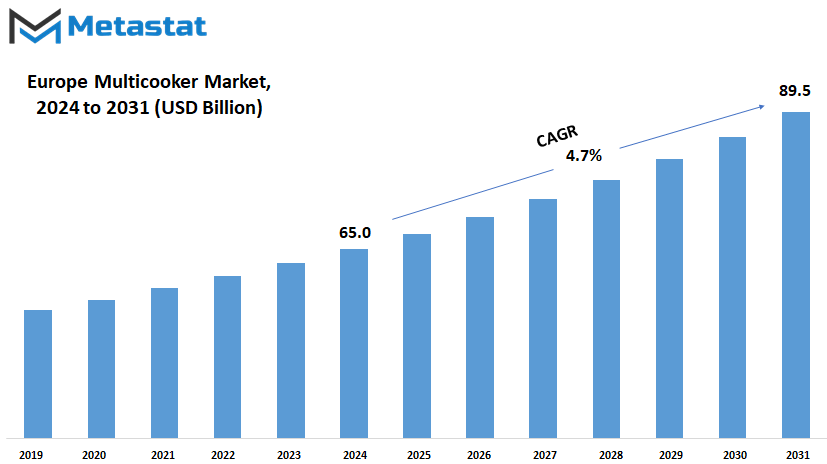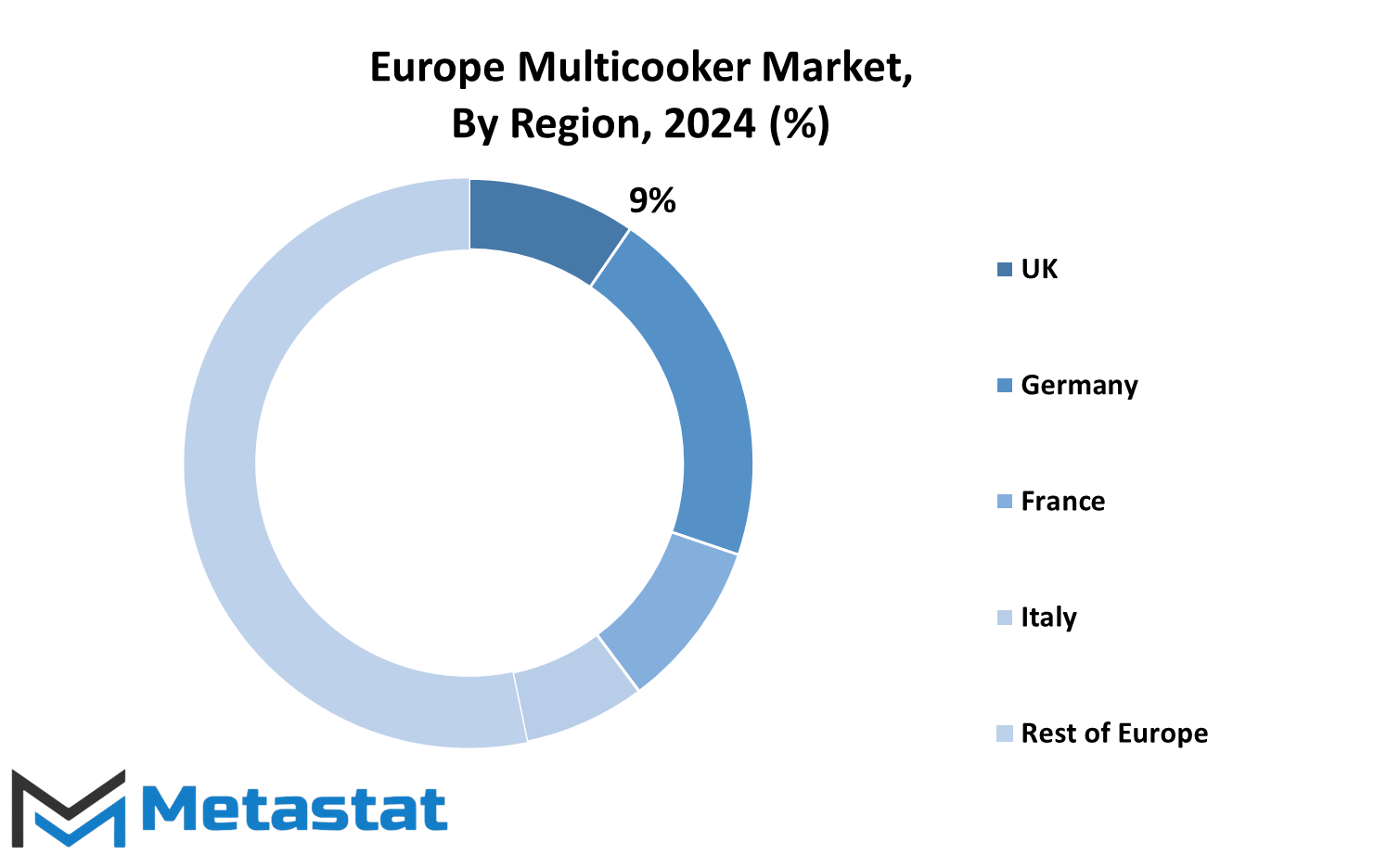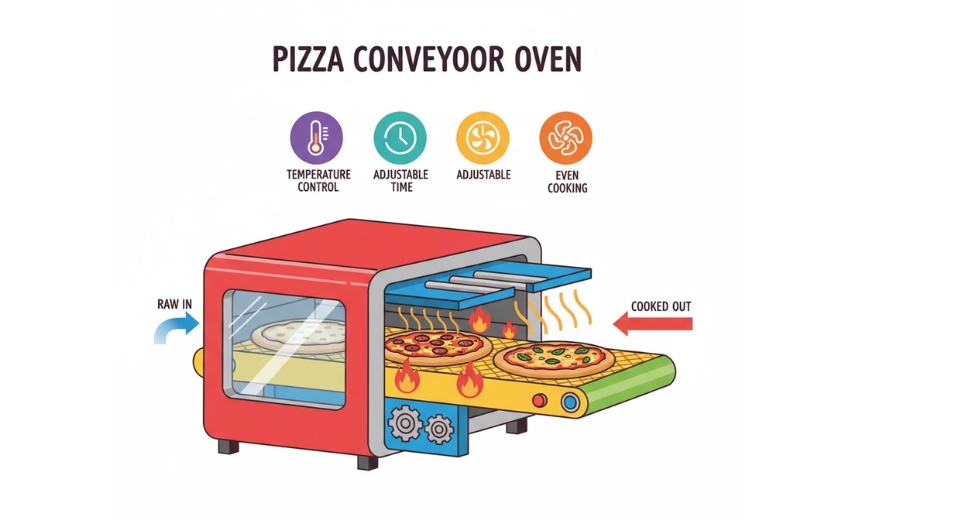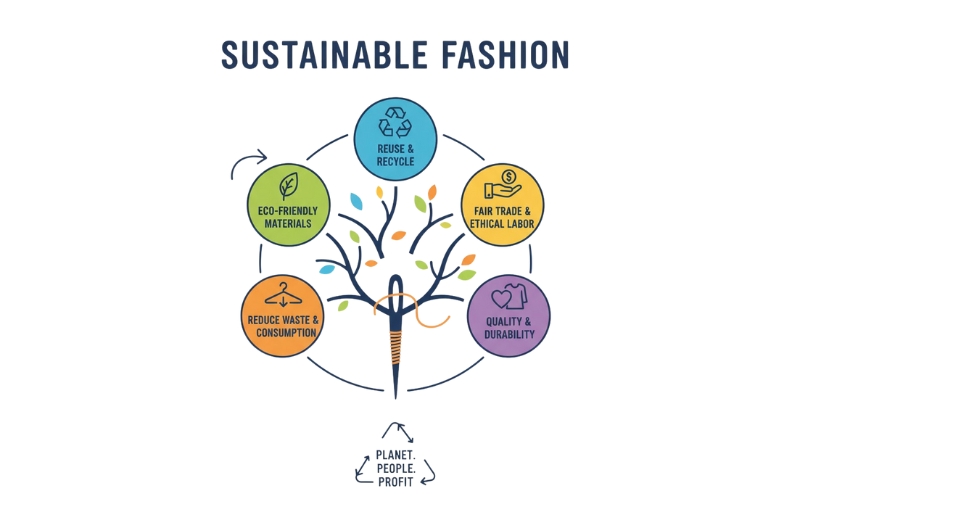MARKET OVERVIEW
An increased demand in the Europe multicooker market will reflect the growing interests of consumers in this region towards a new and convenient application of the kitchen. As lifestyles continue to evolve, so do modes and methods of cooking. Hence, the demand for appliances that simplify the process of meal preparation while offering versatility will change this industry. Multicookers are versatile appliances that combine functions like pressure cooking, slow cooking, sautéing, and steaming in a single unit. The penetration of multicookers to other European households is expected to increase more significantly during the entire forecast period.
Multicookers will be in demand in European countries because the consumers prefer faster cooking, as well as effortless preparation of meals. The appliances will gradually become part of daily life, acting as both an aid to cooking and an indispensable companion for household use. More and more time-strapped people will increasingly buy multicookers in pursuit of busy work schedules and family life with home-cooked meals. Consumers will evidence increasing demand for appliances that have the functionality of preparing various dishes in a few steps.
An important feature of this trend will be the evolution of technology in the design of multicookers. These will be more intelligent and effective, making them smarter, for they will have developed touch screens and be capable of connecting to mobile apps and have set programs for specific cuisines. This means European houses will adjust to the thought of more convenience and accuracy, finding multicookers a good combination. In the future, there would be a thrust towards energy efficiency in the Europe Multicooker market so that consumers can save more time and also cut down energy used for cooking.
Besides technology, the wide range of multicooker models introduced in the market will address the varied preferences of consumers. Product manufacturers will introduce models addressing different consumer segments, such as budget-conscious consumers, technologically adept consumers, and those emphasizing premium appliances. Such diversity will ensure that consumers can easily find a multicooker suitable to their needs-be it making easy weeknight dinners or elaborate meals for special occasions.
In addition, the market will be defined by multifunctional appliances with absolutely nothing related to multicooking. Air fryers, yogurt makers, rice cookers, and bread bakers will achieve the attraction of European consumers in the pursuit of multifunctionality that may replace many standalone kitchen appliances. Multicookers demand may also increase due to people wanting to optimize kitchen space and clutter.
Yet another market area is the growing interest in multicookers allowing for healthier ways of cooking. Because Europeans are experiencing a marked interest in their health, it would be expected that this interest would translate to increasing demands for steaming, low-fat, and other devices that cook healthy food. The ability to provide meals that are low in calories, nutritious, and easy to prepare will be one of the core selling points by the manufacturers of multi-cookers in the future.
Going forward, the Europe Multicooker market is likely to be in pace and accommodate fast-growing demand for sustainable living. Consumers would demand appliances that are energy-efficient and made of green materials, generally aligned with wider trends toward sustainability. In changing preferences from consumers, so will offering from multicooker manufacturers be changed toward environmental sensitivity while still ensuring convenience and versatility for consumers, driving the market.
Technology will combine with consumer demand for convenience and changing preferences toward multifunctionality and sustainability. As part of changing the way people prepare and interact with their kitchen appliances, the Europe multicooker market will also continue to grow.
Europe Multicooker market is estimated to reach $89.5 Billion by 2031; growing at a CAGR of 4.7% from 2024 to 2031.

GROWTH FACTORS
Recent years have seen tremendous changes in the growth of the Europe Multicooker market, and that is exactly what will be witnessed going forward. Higher demand in multicookers occurs when people find the easiest and faster ways of cooking. These devices have quite numerous functions including slow cooking, pressure cooking, steaming, and frying which tends to save a consumer quite a lot of time preparing meals. This is among the major driving factors of the market in Europe. Streamlining the cooking process has become essential as hectic lifestyles are taking over, and multicookers are the perfect answer to that need.
The primary growth factor for the Europe Multicooker market is the growing interest in healthy eating and the need for home-cooked meals. With so many people now becoming more aware of what they eat, multicookers are a chance to provide healthy meals at home with a minimum amount of time in the kitchen. In fact, the food also retains much more vitamins and minerals than is cooked using other methods because it cooks at lower temperatures. Since more consumers will begin adopting healthier diets, demand for such appliances will be on the rise.
Another crucial factor pushing the market up is the increasing availability of smart technology in kitchen appliances. Many latest multicooker models feature Wi-Fi connectivity, smartphone apps, and voice control. With such high-tech appliances, one can easily make changes to cooking settings from a distance, monitor cooking, or even get recipe suggestions. As technology continues to evolve, the demand for these high-tech appliances is poised to grow, influencing mult-cooker demand further.
However, the Europe Multicooker market growth is restricted by certain challenges. Advanced models carry a rather high price tag and this may be a disincentive for price-sensitive customers from buying the product. Not everyone is ready to exploit the new technology and some prefer traditional means of cooking. These shall be deterrents to the adoption rate, especially in those geographies where the customer base is more accustomed to conventional kitchen appliances.
Despite all these hurdles, the market is going to have tremendous opportunity in the coming years. Multicookers are sure to be developed in ways that make them even more eco-friendly as well as energy-efficient, considering the ground which sustainability and energy efficiency continue to see increased focus. Multicooker consumers are proven to become more aware of environmental issues, and as manufacturers focus on producing energy-efficient products, they must attract a wider customer base. Furthermore, that e-commerce is highly set to advance, and this is bound to make multicookers much more accessible to consumers.
Altogether, the end consumer preferences are expected to be towards convenience, health-conscious cooking, and advanced technology, further pushing demand for the Europe Multicooker market. Provided that some of the issues get solved, this market holds much promise and scope in the future through innovative design and technology.
MARKET SEGMENTATION
By Type
The European market is now in high demand for multicookers because of the occupants of the region’s persistent search for simpler ways to cook without forfeiting flavor and quality. This can be attributed to the busy lifestyles of the consumers who are on the hunt for convenient yet effective appliances that can complement their kitchen needs. Because of this, various kinds of multicookers are facing the limelight with every appliance having its own set of features to cater to different requirements. The market is expected to continue its growth along the lines of technical advancements and the growing need for smart home appliances.
The Europe multicooker market can be categorized into several types. The main functionalities of each type have obviously attracted different segments of customers to these products. The most common one among them is the standard multicooker, which offers basic cooking functions. These multicookers are meant for the more basic tasks like boiling, steaming, and slow cooking. They are meant for offering practicality in doing things among those who opt for simple and straightforward cooking solutions. Although they lack several of the high-tech features seen on other multicookers, they can be trusted with those looking for a hassle-free cooking experience.
The multi-function multicooker is another major category which is differentiated from basic cooking. These devices have a wider cooking functions range than the previous, thus allowing users to prepare more diverse dishes. Starting from baking to sautéing and many more in between, these devices serve multiple purposes. Perfect for versatile individuals who want to be spontaneous in the kitchen, the very flexible cookers would attract those who like experimenting but want to have one kitchen appliance that can perform most tasks.
Another is the multi-function cooker with pressure cooking. Multi-functional cooking integrates the advantages of multi-functionality in cooking, with the added advantage of pressure cooking. Pressure cooking enables one to prepare a meal a lot faster while retaining flavors and nutritional value in the food. This multicooker is enjoying greater popularity among users who require meals to be prepared quickly, but the users should not compromise on taste or health.
Europe’s fastest-growing category is the smart multicooker, which involves advanced technology that is controlled via a smartphone or voice assistant. One can use smart multicookers with the following functions: remote control, recipe suggestions, adjustment of cooking parameters, and others, to cook more adventurously than before. As technology is expected to advance further in the upcoming years, more demand for smart appliances like these is expected to be increased in the future, offering even more convenience and customization to home cooks across Europe.
The future of the Europe multicooker market is promising, as consumers widely accept these multi-purpose and time-saving appliances for kitchens. Already, this is a very promising line of markets, especially when the trends are moving further toward even more automated cooking solutions, coupled with further technological development, with the introduction of yet newer and more innovative products according to the needs of modern homes.
By Application
The market for Europe Multicooker is highly growth experiencing and is expected to grow further in the future years. According to factors which boost its growth, it mainly has to do with great demand for multi-cooker appliances, which have seen extreme popularity because they allow facilitating meal preparation for both home cooks and professional chefs. Multicookers have become extremely popular in the European households and businesses to carry out various functions under one device. The market is bifurcated into two major applications: household cooking and commercial cooking, which have trends as well as opportunities associated with them.
Residential Cooking
There is quite a need for multicookers due to the busyness of people today. Many Europeans look for ways to make meal preparation easier, and a multicooker has all those functions-namely, pressure cooking, slow cooking, steaming, and even baking under one appliance. That will appeal particularly to families and people working beyond office hours to prepare their meals. While the demand for multicookers is expected to continually grow for residential use in cooking. The interest in health and wellness is growing, which attracts the consumers to the multicooker for easy preparation of healthy meals that further drives the growth of the Europe Multicooker market in this particular segment.
On the other side, commercial cooking also shows growth due to professional kitchens' attempt to find ways to increase productivity and reduce cooking time. A multicooker can also be a great option for busy commercial kitchens that prepare large quantities of food. In fact, there are even catering services and restaurants where multicookers are used because of their efficiency in producing large quantities without sacrifices in taste and quality. Multicookers will be the most liked solution for commercial establishments in the food service industry, increasing efficiency and meeting demands for fast, high-quality food.
Europe Multicooker will exhibit new inventions and improvements. Technological advancement will definitely open up a brighter future for a user-friendly, energy-efficient appliance that can cook any type of food. The smart features, including app connectivity and voice control, will increasingly become the norm in most models to make them even more comfortable for residential as well as commercial users. Sustainability concerns will drive the development of more energy-efficient and environmentally friendly multicookers as their marketing will also focus on reducing the ecological footprint while delivering the same level of quality performance in cooking. Overall, the Europe Multicooker market will continue to grow on its own, and more dominant roles in the future will be held by its residential and commercial applications.
|
Report Coverage |
Details |
|
Forecast Period |
2024-2031 |
|
Market Size in 2024 |
$65.0 billion |
|
Market Size by 2031 |
$89.5 Billion |
|
Growth Rate from 2024 to 2031 |
4.7% |
|
Base Year |
2022 |
|
Regions Covered |
North America, Europe, Asia-Pacific Green, South America, Middle East & Africa |
REGIONAL ANALYSIS
The Europe Multicooker market is increasing very rapidly and promises to be a wonderful market for the future. Very distinct regional trends do exist when looking at regional trends, and indeed, it is very obvious that Europe is one of the regions in front, propelling this market forward. The market across Europe includes big counties such as the United Kingdom, Germany, France, and Italy among others. These all fall under "Rest of Europe." The classification allows for informed knowledge of how different regions in Europe are working to further the general growth and development of multifunction cooker technology.
Demand for multicookers in Europe will continue to grow through shifting demand towards greater convenience and multifunctionality when it comes to appliances in the kitchen. The more Europeans turn to smart cooking solutions, the more they will be led towards multicookers: these options offer multiple functions in one product-styles of cooking. This will meet the growing demand for space efficiency, especially in urban areas where kitchens tend to be smaller. This will create a growing market for consumers who want to reduce the length of their cooking time without sacrificing the productivity or quality of their meals while still being able to prepare a variety of meals.
Several factors will make the market of Europe Multicooker grow in the future. These include increased interests in healthy cooking procedures. Consumers in Europe are becoming more health-conscious, searching for ways to prepare nutritious meals that are prepared quickly with minimal efforts. As a result, multicookers remain in demand since it offers several procedures like steaming, slow cooking, and pressure cooking.
However, as technology will further evolve, multicookers become more intelligent, implementing lots of features for the digital generation. It is the integration feature to control cooking setting on smartphones or voice assistants which even increases appealability in Europe. Multicookers become energy efficient; it is one of the positive benefits: cooking can now be done faster, in comparison with traditional means, as it will be influenced by the wave of sustainability.
Overall, the Europe Multicooker market will continue its ascent through convenient, efficient, and sustainable cooking solutions as consumers in the region seek. It would be technological innovation and change in the demands of lifestyle that spurred the use of these appliances.

COMPETITIVE PLAYERS
The Europe Multicooker market is a dynamic and competitive sector where several well-established players are working to shape the growth process. Companied with rising consumer demands for convenience and multifunctional cooking appliances, these companies work towards innovation, product differentiation, and further expansion into the market. This transformation is driven by some central players such as Beper S.r.l., Vesync Co., Ltd (Cosori), Newell Brands (Crock-Pot), Instant Brands, Midea Group, and SharkNinja Operating, LLC.
The trend most apparent in the European multicooker market will be increasing demand for appliances that are versatile and easy to use. A critical aspect of these brands is to have a focus on combining multiple cooking functions into a single appliance, catering to the need of the modern consumer for ease in saving time. Multicookers which combine pressure cooking, slow cooking, steam cooking, sautéing, and even air frying-have become very popular and famous brands such as Instant Brands and Newell Brands with Crock-Pot. It appeals to European household more and more and towards things which decline unnecessary clutter in the kitchen while giving them diversity of cooking options.
The Europe Multicooker market is impacted by the competition due to the technological advance. Most of the companies, such as Midea Group, SharkNinja Operating, LLC, and Tefal S.A.S., integrate smart features into their products, allowing users to control them from a mobile application or a voice assistant. Convenience is one of the key selling points for such products, especially for the new generations, who appreciate connectivity as well as convenience. The continuous development of more user-friendly interfaces and more energy-efficient cooking options further makes multicookers very attractive on the European market.
Also, companies like Redmond and Rommelsbacher ElektroHausgeräte GmbH and Cecotec Nordic A/S that market to specific regional tastes through multicookers that would suit a particular type of cooking style and taste in other European countries. In this regard, a regional strategy will also find their interest of consumers who are being sought by their cooking traditions.
The competition will also hot, and market players will focus more on expansion of product lines, improvement in customer experience, and affordability of products. In this way, the Europe Multicooker market will continue to innovate and grow in comparison to the growing interest of consumers in home cooking and an increased need for easy functionality. These players will continue to evolve these key products into even more sophisticated multicookers to allow for greater efficiency, greater adaptability, and more functionality with further needs across the dynamic face of the European kitchen.
Europe Multicooker Market Key Segments:
By Type
- Standard Multicooker (Basic Cooking Functions)
- Multi-function Multicooker
- Multi-function Multicooker (Pressure Cooking)
- Smart Multicooker
By Application
- Residential Cooking
- Commercial Cooking
By Sales Channel
- Direct Sales
- Retail Stores
- E-Commerce
- Distributors and Wholesalers
Key Europe Multicooker Industry Players
- Beper S.r.l.
- Vesync Co., Ltd (Cosori)
- Newell Brands (Crock-Pot)
- Instant Brands
- Midea Group
- SharkNinja Operating, LLC
- Redmond
- Rommelsbacher ElektroHausgeräte GmbH
- Spectrum Brands, Inc. (Russell Hobbs)
- Tefal S.A.
- Drew & Cole
- Cecotec Nordic A/S
- Koninklijke Philips N.V.
- BSH Home Appliances Ltd
WHAT REPORT PROVIDES
- Full in-depth analysis of the parent Industry
- Important changes in market and its dynamics
- Segmentation details of the market
- Former, on-going, and projected market analysis in terms of volume and value
- Assessment of niche industry developments
- Market share analysis
- Key strategies of major players
- Emerging segments and regional growth potential








 US: +1 3023308252
US: +1 3023308252






